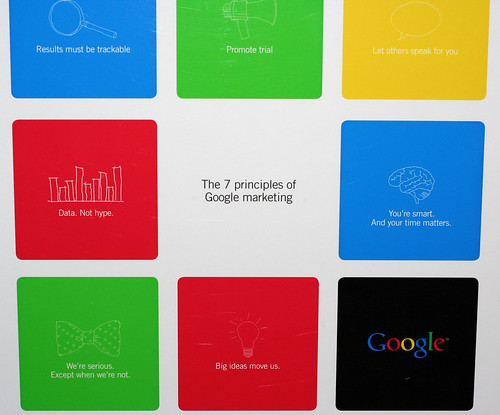Its inevitable that all TV viewing will be done online in the future because the choice is better (although something will need to be done about
choice paralysis) and time and space are no longer constraining factors.
Time is irrelevant because shows can be called up on-demand, making the 'old' system of programming look as silly as everyone being served up with the exact same meal in a restaurant. Space - or location - is irrelevant because although TVs are stationary, screens are mobile. Content can be picked up anywhere as long as you have access to
the cloud.
Online TV also has the chance to be interactive.
People are already using traditional TV and online together to enhance the experience (and
here). Online TV will just remove the space between laptop and TV, packing it down into one device.
Because of this inevitability, the move by
Hulu to exploit the interactivity of the medium is
a good thing.
If online TV is going to be
free, it's going to have to be ad supported. It could be charged but when you have free vs paid, free will win out as long as the 'costs of free' aren't too great.
The 'cost of free' being advertising and the 'too great' bit being when the ads subtract significantly from the experience by being intrusive and/or irrelevant.
By adding choice to the ad serving process the costs are lessened because people will feel they have some choice in the matter and - now going beyond what is happening at
Hulu - choice might improve
relevance, the nirvana of advertising that has allowed Google to make billions.
I've got a few ideas about how more choice can be added into the mix to make people feel more in control and to give them better (more relevant) ads.
The first thing to note is the gulf between products on a show and buying them. The Internet could close this gap to a few centimeters. Take for example House's leather jacket, something that keeps him both "warm and cool" and something that was probably just chosen by the
show's wardrobe people rather than any money changing hands for its use.

Yet,
there is demand for his jacket; people are asking where to buy one. It would be fairly simple to have an overlay with a tagging system similar to
Facebook's (below), except rather than being static, it would be dynamic;
hypervideo. The tags would be put in place by the production team or automatically once the technology gets good enough at object recognition.
 The lovely Kate, tagged on Facebook
The lovely Kate, tagged on FacebookEverything in a show becomes a
clickable object. Links out to products could be collected on a little 'shelf' which you could sift through at the end of the show. The transient nature of things in video becomes irrelevant. Clothes worn, gadgets used, songs played could all be put on the 'shelf' for later inspection and possible purchase. People could chose a specific type of ad (like clothing, gadgets or music) depending on their whim. I would find this much more useful than
interupting messages or even a
pre-show ad.
For some, this might seem rather unpleasant because of the risk of corrupting artistic output. This is as
naïve as the idea of the
sentimentalist idea of the noble savage because creativity has always used the oxygen of commerce. John
Hegarty,
BBH's creative supremo, uses Titian's
The Annunciation as an example: "In the bottom right-hand corner you will see a decanter. Why? Well, the Venetians had developed clear glass and they wanted it in there as an advert. So the connection between culture and commerce is hundreds of years old." (
source)
 Titian's The Annunciation (click to enlarge)
Titian's The Annunciation (click to enlarge)Second, I agree with
Hegarty's other point that the only problem with such placement is when it is done badly, when it is perpendicular to the story. It reminds me of the deliberately obtuse
faux product placement in the
Truman Show by Truman's synthetic wife:

In this situation both show and brand come off looking bad. As
Hegarty says, "It doesn't satisfy the viewer, so it doesn't work for the advertiser" (also see this
paper by Nigel Hollis, Chief Global Analyst at
Millward Brown for more on this). Put differently, corrupting artistic output is not in the interests of either the people making the shows or the advertisers.
I would much rather have something like this, where I get to chose the ads in a more ecologically valid environment than have my viewing experience lacerated by the tyranny of jingles and over-enthusiastic voice overs. And with the
long tail this could be very profitable for shows and films.
Advertising is here to stay. The more useful we can make it the better it will be for all involved. And one way to do this is let people have more choice about the ads they consume.




















































